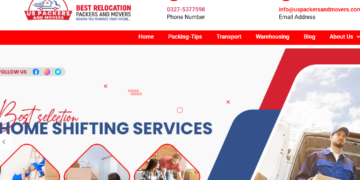Maintaining the right temperature in a warehouse is critical for a smooth and efficient operation. Warehouse cooling plays a significant role in preserving inventory, enhancing employee productivity, and meeting regulatory standards. With the growing need for businesses to optimize their operations, understanding warehouse cooling solutions is more important than ever.
Understanding Warehouse Cooling
Warehouse cooling refers to the methods and systems employed to regulate and control the temperature inside large storage spaces. This includes cooling systems like air conditioning, evaporative cooling, and specialized refrigeration used to create a stable and comfortable environment for both products and personnel.
Why Is Warehouse Cooling Important? Warehouse cooling is essential for several reasons, including:
- Product Preservation: Many goods, especially perishable products like food and pharmaceuticals, require temperature-controlled environments to prevent spoilage.
- Worker Comfort: A comfortable environment enhances worker productivity and reduces the risk of heat-related illnesses.
- Regulatory Compliance: Many industries, particularly food and healthcare, have stringent temperature requirements to meet safety standards.
Types of Warehouse Cooling Systems
There are several cooling systems that warehouses commonly use, depending on their size, location, and the specific needs of the business. Below are the most popular warehouse cooling solutions:
1. Centralized Air Conditioning Systems
Centralized air conditioning (AC) systems provide consistent and controlled cooling throughout the warehouse. These systems are often used for temperature-sensitive products and are ideal for large warehouses with high ceilings.
- Pros:
- Efficient for large spaces.
- Controls humidity and temperature uniformly.
- Reduces energy usage compared to individual units.
- Cons:
- Initial installation costs can be high.
- Maintenance requires skilled professionals.
2. Evaporative Coolers (Swamp Coolers)
Evaporative coolers use water to cool the air, making them a cost-effective and environmentally friendly solution for areas with dry climates. These systems work by drawing warm air through moist pads and releasing cool air into the space.
- Pros:
- Low installation and maintenance costs.
- Energy-efficient.
- Suitable for dry climates.
- Cons:
- Not effective in humid environments.
- Water usage can be high.
3. Refrigerated Cooling
Refrigerated cooling is a must for cold storage warehouses. These systems use compressors and refrigerants to cool air and maintain specific temperature ranges necessary for frozen or perishable goods.
- Pros:
- Essential for industries like food and pharmaceuticals.
- Highly precise temperature control.
- Cons:
- Expensive to install and operate.
- Requires regular maintenance.
4. Ceiling Fans and Exhaust Fans
Ceiling and exhaust fans are simpler solutions for improving air circulation in warehouses that do not require intense cooling. These fans help distribute cooler air, especially in spaces with naturally lower temperatures.
- Pros:
- Cost-effective.
- Easy to install and maintain.
- Enhances air circulation.
- Cons:
- Limited cooling capacity.
- Only effective in moderate climates.
Factors to Consider When Choosing a Cooling System
Selecting the right warehouse cooling system depends on several key factors. Businesses must evaluate each of the following before deciding on the most suitable solution:
1. Size of the Warehouse
Larger warehouses require robust cooling systems, such as centralized air conditioning or refrigeration, while smaller warehouses may benefit from ceiling fans or evaporative coolers.
2. Climate and Location
The local climate will significantly impact the effectiveness of certain cooling systems. For instance, evaporative coolers work best in dry, hot climates but can struggle in humid conditions. Refrigeration systems, on the other hand, can be used in all climates but are more expensive to run.
3. Type of Products Stored
Different products have varying temperature requirements. Perishable goods like fruits, vegetables, and meats need refrigeration, while electronics, furniture, and other non-perishables may only require air circulation.
4. Energy Efficiency
Energy consumption is a major consideration in warehouse cooling, as these systems can consume a significant amount of electricity. It’s essential to consider energy-efficient solutions that lower long-term operating costs while maintaining a comfortable temperature.
5. Cost of Installation and Maintenance
Upfront costs and ongoing maintenance fees vary widely among cooling systems. Evaporative coolers and ceiling fans are cost-effective, while refrigerated systems and centralized AC can be more expensive to install and maintain.
Frequently Asked Questions (FAQs)
1. What is the best cooling solution for a warehouse with high ceilings?
For warehouses with high ceilings, a centralized air conditioning system or a large-scale evaporative cooling solution is typically the best choice. These systems can efficiently cool large areas and manage temperature variation across different parts of the warehouse.
2. Can I use ceiling fans instead of air conditioning for cooling a warehouse?
Ceiling fans can be an effective solution for improving air circulation in warehouses that do not need extensive cooling. However, for temperature-sensitive products or areas requiring significant cooling, air conditioning may be necessary.
3. How can I reduce cooling costs in my warehouse?
To reduce cooling costs, consider implementing energy-efficient systems, maintaining optimal insulation, and regularly servicing equipment to ensure it runs at peak efficiency. Additionally, using programmable thermostats can help regulate the temperature and reduce energy consumption.
4. Is evaporative cooling effective in humid environments?
Evaporative cooling systems are less effective in high humidity because they rely on moisture evaporation to cool the air. In humid conditions, these systems may struggle to provide adequate cooling, and a refrigerated system might be a better option.
5. What temperature range should be maintained in a warehouse for food storage?
The temperature range for food storage in a warehouse typically falls between 35°F to 45°F (1.6°C to 7.2°C) for fresh items, while frozen goods should be stored at temperatures below 32°F (0°C).
Key Benefits of Proper Warehouse Cooling
1. Improved Inventory Control
Maintaining the correct temperature ensures that products are stored in optimal conditions, reducing spoilage and wastage. This is particularly important in the food, pharmaceutical, and chemical industries.
2. Enhanced Worker Productivity
A cool and comfortable working environment increases employee focus, reduces fatigue, and enhances overall productivity. Extreme temperatures can lead to heat stress, which negatively impacts employee performance and well-being.
3. Regulatory Compliance
Many industries are required by law to adhere to specific temperature regulations. Proper cooling systems help businesses stay compliant with health and safety standards, avoiding penalties and maintaining customer trust.
4. Energy Efficiency and Sustainability
Choosing the right cooling system can reduce energy consumption, benefiting both the environment and the bottom line. Many modern cooling systems are designed to be energy-efficient, offering long-term savings.
Comparing Warehouse Cooling Solutions
| Cooling System | Best For | Pros | Cons |
|---|---|---|---|
| Centralized Air Conditioning | Large warehouses with temperature-sensitive products | Uniform temperature, energy-efficient | High installation and maintenance costs |
| Evaporative Coolers | Dry climates, medium-sized warehouses | Cost-effective, environmentally friendly | Not suitable for humid conditions |
| Refrigerated Cooling | Cold storage, perishable goods | Precise temperature control | Expensive installation and operation |
| Ceiling Fans | Moderate climates, small warehouses | Low cost, simple to install | Limited cooling capacity |
Conclusion
Efficient warehouse cooling is a cornerstone of operational success, ensuring product quality, employee safety, and regulatory compliance. Whether opting for centralized air conditioning, evaporative cooling, or refrigerated systems, businesses must carefully consider the size, climate, and type of goods stored in their warehouse. By choosing the right solution, warehouse managers can enhance productivity, reduce costs, and maintain a safe and efficient working environment.


















